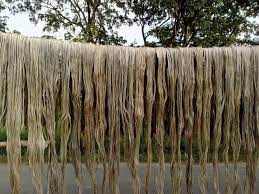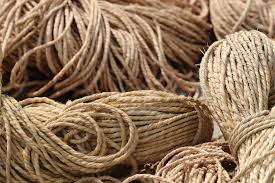Jute Inner bark is a long, soft, and shiny plant fiber that is primarily extracted from the inner bark of the jute plant (Corchorus species). The jute plant is native to the Indian subcontinent and is cultivated in various tropical regions around the world. It is known for its economic importance due to its versatile applications in the textile and agricultural industries.
The jute fiber is obtained from the phloem region, which is the inner bark of the jute plant stems. The process of extracting the fiber involves retting, where the harvested stems are immersed in water to allow natural enzymes to break down the non-fibrous materials, making it easier to separate the fibers. After retting, the fibers are stripped from the stalks, and the inner bark is cleaned to remove any impurities.
The jute inner bark fibers are long and strong, with a golden to off-white color, depending on the processing method and age of the plant. They have high cellulose content, which gives them excellent tensile strength and durability. These properties make jute fibers suitable for various applications in the textile industry, such as manufacturing sacks, bags, ropes, carpets, and other coarse fabric products.
Apart from textiles, jute inner bark fibers also have agricultural uses. They are often used for erosion control, as they help in stabilizing soil and preventing soil erosion in embankments and other areas prone to erosion. Jute fibers are biodegradable and environmentally friendly, making them a sustainable choice in several applications.
Overall, the jute inner bark is a valuable source of natural fibers that find wide-ranging use due to their strength, versatility, and eco-friendliness. The demand for jute products has been increasing in recent years as people become more conscious of sustainable and eco-friendly alternatives to synthetic materials
Economic Importance, Uses, and By-Products of Jute Inner bark

Jute is a versatile natural fiber that comes from the outer stem of the jute plant (Corchorus species). The inner bark of the jute plant, also known as the phloem or bast, is primarily used in various industrial applications. Here are some of the economic importance and uses of jute inner bark:
1. Jute Fiber Production: The most significant economic importance of jute inner bark lies in its use as a raw material for jute fiber production. The fibers are extracted from the inner bark through a process called retting, where the stems are soaked in water to facilitate the separation of fibers. Once extracted, jute fibers are spun into threads, which are then used to make various products.
Example: Jute sacks and bags are widely used for packaging agricultural products, such as grains, coffee, and cocoa. The durability and natural breathability of jute fibers make them ideal for storing and transporting these goods.
2. Textile Industry: Jute fibers are also utilized in the textile industry to create fabrics, ropes, and twines. The inner bark’s fibrous nature gives jute fabrics a coarse texture, making them suitable for various applications.
Example: Hessian cloth, a woven jute fabric, is commonly used for making sacks, curtains, upholstery, and carpets due to its affordability and strength.
3. Handicrafts and Decorative Items: Jute fibers are frequently used in crafting various decorative and utility items. The inner bark’s flexibility and ease of dyeing make it popular in creating handicrafts.
Example: Jute wall hangings, decorative baskets, and coasters are some of the handicraft products made from jute fibers.
4. Soil Erosion Control: Jute nets and mats made from jute fibers are employed in soil erosion control. These materials help stabilize soil on slopes and riverbanks, preventing erosion and supporting vegetation growth.
Example: Jute geotextiles are used in environmental restoration projects, such as stabilizing riverbanks to prevent flooding and protecting slopes from erosion.
5. Biodegradable Packaging: With growing concerns about environmental sustainability, jute has gained attention as an eco-friendly alternative to plastic and other non-biodegradable packaging materials.
Example: Jute wine bottle bags, shopping bags, and food packaging are increasingly used as eco-conscious alternatives in the packaging industry.
6. Agro-Textiles: Jute fibers are blended with other materials to create agro-textiles that serve various agricultural purposes.
Example: Jute-based agro-textiles are used as shade nets, anti-hail nets, and mulching sheets to protect crops from adverse weather conditions and promote better crop growth.
7. Building Materials: Jute fibers can be mixed with cement and other materials to create a composite known as “jute-reinforced composite” or “jute fiber-reinforced polymer.” This composite is used as a low-cost and environmentally friendly building material.
Example: Jute-reinforced composite panels can be used for walls, doors, and roofing in affordable housing projects.
8. Paper and Pulp Industry: The inner bark of the jute plant is also used to produce paper and pulp, providing an eco-friendly alternative to wood-based paper production.
Example: Jute paper is used in various applications, such as stationery, gift wraps, and packaging materials.
9. Handicrafts and Fashion Industry: Jute fibers have found their way into the fashion and handicrafts industry due to their eco-friendly and rustic appeal.
Example: Jute is used in making fashion accessories like hats, handbags, and footwear, as well as in crafting home decor items like lampshades and rugs.
Read Also : Economic Importance, Uses, and By-Products of Jute Outer bark
10. Furniture and Upholstery: Jute fabrics are also employed in furniture and upholstery to add a natural touch to interior design.
Example: Jute-upholstered furniture pieces, such as chairs and sofas, are becoming popular in eco-friendly and sustainable home decor.
11. Industrial Applications: Jute fibers possess excellent insulating properties and are used in various industrial applications.
Example: Jute insulating materials are used in the automotive industry for noise reduction and as an insulator in electrical cables.
12. Employment Generation: Jute cultivation and processing provide employment opportunities for millions of people, especially in jute-producing regions.
Example: Countries like India and Bangladesh are major producers of jute, and its cultivation supports the livelihood of many rural communities.
Overall, the economic importance of jute inner bark extends to a wide range of industries and applications, making it a valuable natural resource. Its eco-friendliness, biodegradability, and sustainability have contributed to the growing popularity of jute-based products in global markets. As consumer awareness about environmental issues increases, the demand for jute products is expected to rise further, offering economic benefits while promoting sustainable practices in various sectors.
The inner bark of the jute plant contains two primary components: fibers and hurd. These components can be processed to yield several products and by-products. Let’s explore them along with their examples and processes:
The Products and By-products That Can Be Derived From Jute Inner bark

1. Jute Fiber: Jute fibers are the primary product obtained from the inner bark of the jute plant. They are long, soft, and shiny, with high tensile strength and low extensibility.
Example: Jute fiber is widely used in the manufacturing of sacks, bags, ropes, twine, carpets, mats, and other textile products.
Process: After harvesting the jute plant, the stems are soaked in water to facilitate the separation of fibers from the hurd. The jute fibers are then extracted by a process called “retting,” where the stems are subjected to microbial action in water for a specific period. After retting, the fibers are stripped from the stalks and then washed, dried, and graded.
2. Jute Hurd (core): Jute hurd is the woody core or the inner pith of the jute plant. It is a by-product of the jute fiber extraction process.
Example: Jute hurd can be used for making particleboard, paper pulp, and horticultural mulches.
Process: After the retting process, the jute hurd is separated from the fibers. It can be further processed for various applications.
3. Jute-based Composite Materials: Jute fibers can be combined with other materials to create composite materials, imparting them with enhanced mechanical properties and sustainability.
Example: Jute-reinforced composite materials are used in the automotive industry for manufacturing car interiors, door panels, and other components.
Process: Jute fibers are mixed with resins or other binding materials and subjected to compression or molding processes to create composite materials.
4. Jute Paper: Jute fibers can be used to produce paper and paper-based products.
Example: Jute paper is used for packaging, stationery, and other paper applications.
Process: The jute fibers are pulped and processed through standard papermaking techniques to produce jute paper.
5. Jute Geo-textiles: Jute fibers are used to create geo-textiles, which are permeable fabrics used for erosion control and soil stabilization.
Read Also : Economic Importance, Uses, and By-Products of Jute Lignin
Example: Jute geo-textiles are used in slope stabilization, road construction, and riverbank protection.
Process: Jute fibers are woven or knitted to create the geo-textile fabrics, which are then installed in the desired areas.
6. Jute-based Insulation Materials: Jute fibers can be used in the production of thermal and acoustic insulation materials.
Example: Jute insulation materials are used in buildings and industrial applications for energy efficiency and soundproofing.
Process: Jute fibers are processed with suitable additives to create insulation materials like mats, rolls, or boards.
7. Jute-based Biodegradable Plastics: Jute fibers can be utilized to reinforce biodegradable plastics, reducing their environmental impact.
Example: Jute-reinforced biodegradable plastic products, such as cutlery and packaging materials, offer a more eco-friendly alternative to conventional plastics.
Process: Jute fibers are mixed with biodegradable plastic resins and processed through injection molding or other plastic-forming techniques.
8. Jute Charcoal: Jute hurd can be carbonized to produce jute charcoal, which has various applications in industries and as a fuel source.
Example: Jute charcoal is used in metallurgical processes, water purification, and as a cooking fuel in some regions.
Process: Jute hurd is subjected to pyrolysis, a process where it is heated in the absence of oxygen, leading to the conversion of the organic material into charcoal.
9. Jute Handicrafts and Decorative Items: Jute fibers can be creatively crafted to produce a wide range of handicrafts and decorative items.
Example: Jute wall hangings, lampshades, coasters, baskets, and fashion accessories like hats and jewelry are popular jute-based handicrafts.
Process: Skilled artisans weave, knit, crochet, or macramé jute fibers to create various artistic and functional items.
10. Jute Yarn and Twine: Jute fibers can be spun into yarns and twines of various thicknesses for different applications.
Example: Jute yarn is used in textiles, knitting, and weaving industries. Jute twine is widely used for packaging, gardening, and crafts.
Process: After retting and extraction of fibers, the jute fibers are combed, aligned, and spun into yarns and twines.
11. Jute Agro-textiles: Jute fibers can be used as agro-textiles, which are materials designed to enhance agricultural productivity and protect crops.
Example: Jute agro-textiles are used for shade nets, crop covers, nursery bags, and soil erosion control in agricultural practices.
Process: Jute fibers are woven or knitted to create agro-textile products suitable for various agricultural applications.
12. Jute Soap Bags and Scrubbers: Jute fibers can be used to create soap bags and scrubbers for personal care and cleaning purposes.
Example: Jute soap bags are used to hold and apply soap while exfoliating the skin. Jute scrubbers are used for cleaning dishes and surfaces.
Process: Jute fibers are knitted or woven into the desired shape to create soap bags and scrubbers.
13. Jute-based Activated Carbon: Jute hurd can be converted into activated carbon, which has excellent adsorption properties and is used in various applications.
Example: Jute-based activated carbon is used in air and water purification, gas masks, and medical applications.
Process: Jute hurd is first carbonized and then activated through a process that creates a porous structure, enhancing its adsorption capacity.
The diverse range of products and by-products derived from jute inner bark highlights the plant’s sustainability and its contribution to various industries. Moreover, the utilization of jute-based materials helps promote eco-friendly alternatives in today’s environmentally conscious world.
Read Also : 14 Health Benefits of Bitter Leaf (Vernonia Amygdalina)
